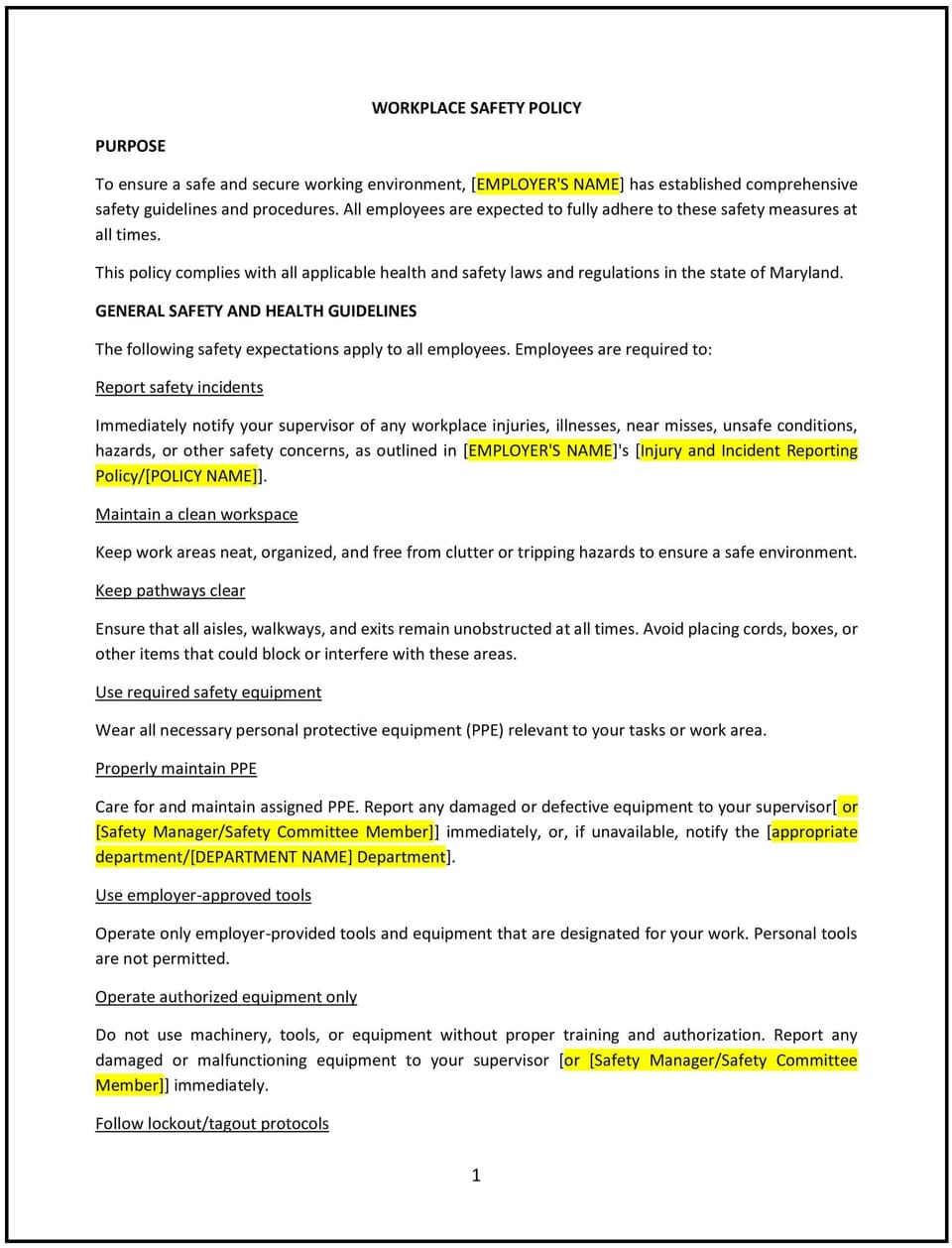Workplace safety policy (Maryland): Free template

Workplace safety policy (Maryland)
This workplace safety policy is designed to help Maryland businesses maintain a safe work environment by outlining safety procedures, responsibilities, and protocols for preventing accidents and ensuring the well-being of all employees. It defines safety expectations, reporting mechanisms, and the role of both employers and employees in maintaining a safe workplace.
By adopting this policy, Maryland businesses can create a culture of safety, reduce the risk of workplace accidents, and improve employee productivity and morale.
How to use this workplace safety policy (Maryland)
- Define workplace safety standards: Clearly outline what constitutes a safe work environment, including proper training, safe equipment, emergency procedures, and workplace behavior expectations.
- Set employee responsibilities: Specify the responsibilities of employees in maintaining safety, such as adhering to safety protocols, using protective equipment, and reporting hazards.
- Establish reporting procedures: Create a process for employees to report safety hazards or accidents, including who to contact and the required documentation.
- Provide training: Outline the required safety training for employees, including specific training for high-risk tasks or environments, and how often it will be provided.
- Address emergency preparedness: Detail the procedures for responding to emergencies, such as fires, medical emergencies, or natural disasters, and assign clear roles and responsibilities during such events.
- Reflect Maryland-specific considerations: Ensure the policy is aligned with Maryland state laws and regulations related to workplace safety, including OSHA (Occupational Safety and Health Administration) requirements and other local regulations.
Benefits of using this workplace safety policy (Maryland)
Implementing this policy provides Maryland businesses with several advantages:
- Reduces workplace accidents: Clearly defined safety protocols and procedures help minimize the risk of workplace injuries and accidents.
- Enhances employee well-being: A safe work environment supports the physical and mental health of employees, which can increase morale and productivity.
- Demonstrates commitment to safety: Shows that the company prioritizes employee safety, which can enhance employee trust and engagement.
- Minimizes legal risks: Helps businesses comply with workplace safety laws, reducing the risk of fines, penalties, or legal action due to unsafe working conditions.
- Improves operational efficiency: A safer work environment leads to fewer accidents, reduced downtime, and better overall productivity.
Tips for using this workplace safety policy (Maryland)
- Communicate clearly: Ensure that all employees are aware of the policy, the safety protocols in place, and their role in maintaining a safe work environment.
- Provide ongoing training: Regularly conduct safety training to ensure employees are familiar with safety procedures, equipment, and emergency responses.
- Foster a safety-first culture: Encourage employees to take personal responsibility for their safety and the safety of their coworkers, and ensure that safety is prioritized in daily operations.
- Conduct regular safety audits: Implement regular safety audits and inspections to identify and address potential hazards or gaps in safety procedures.
- Review regularly: Periodically review the policy to incorporate any changes in Maryland safety laws, industry standards, or internal practices.
Q: What are the primary responsibilities of employees under this policy?
A: Employees are responsible for adhering to safety protocols, using required personal protective equipment (PPE), reporting safety hazards or incidents, and participating in safety training.
Q: How should businesses handle safety hazards that employees report?
A: Businesses should promptly investigate reported safety hazards, take corrective actions to mitigate the risk, and communicate any changes to safety procedures to employees.
Q: Do businesses need to provide safety training for all employees?
A: Yes, businesses must provide safety training for all employees, including specific training for high-risk tasks or environments. The policy should specify the types of training required and how often it will be provided.
Q: What should businesses do in case of an emergency?
A: Businesses should establish clear emergency procedures, designate emergency response teams, and conduct regular drills to ensure employees know how to respond to emergencies like fires, medical incidents, or natural disasters.
Q: Can employees be disciplined for failing to follow safety protocols?
A: Yes, failure to follow safety protocols can result in disciplinary action, including warnings, retraining, or more severe consequences depending on the severity of the violation.
Q: How can businesses ensure that safety policies are followed consistently?
A: Businesses should conduct regular safety audits, provide ongoing training, and establish clear channels for reporting hazards. Employees should be encouraged to take personal responsibility for safety, and management should lead by example.
Q: What should businesses do if they identify recurring safety issues?
A: Businesses should take a proactive approach to addressing recurring safety issues by reviewing safety procedures, identifying root causes, and implementing more effective safety measures or training.
Q: How often should the workplace safety policy be reviewed?
A: The policy should be reviewed annually or whenever there are changes in Maryland safety laws, workplace regulations, or internal procedures to ensure it remains effective and compliant.
This article contains general legal information and does not contain legal advice. Cobrief is not a law firm or a substitute for an attorney or law firm. The law is complex and changes often. For legal advice, please ask a lawyer.


